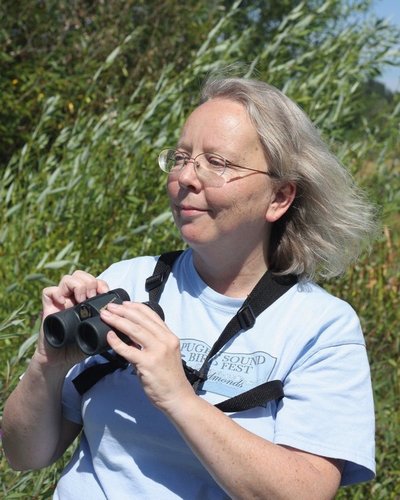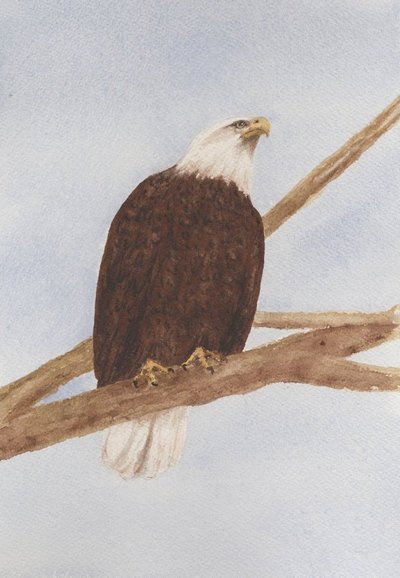June 24, 2010
Accident brings new beginning for talented staffer
Alex MacKenzie’s lucky streak began when she was hit by car. The accident itself wasn’t a good thing, of course — and yet, if it hadn’t happened, a lot of other things might not have happened either.
But let’s back up. MacKenzie is a curriculum coordinator in biostatistics, where she’s worked for nearly 20 years. She is, however, also a writer and artist who studied art history and literature and earned a certificate in scientific illustration from the UW. Though she loves her job, she had always used her spare time to write and to paint and had hoped to publish her work. But except for a few short story sales, she hadn’t been successful. A novel she wrote remained tucked away, unsold.
“I was just about to say, I’m going to stop doing this. I’m tired of it,” MacKenzie said. “I’m in my 50s now and it isn’t an overwhelming passion anymore.”
Then one day in February of 2008, MacKenzie was crossing a street pushing her aged dachshund George in a stroller, when an elderly driver in a heavy, 1985 Chrysler hit her. MacKenzie was knocked to the ground, badly bruised and shaken up enough that she took some sick time to recover. (George, you’ll be happy to know, was not hurt.)
That’s when she started looking for another activity, preferably something physical. “I wanted to find something that would inspire me,” said MacKenzie. “I’ve never been able to find an exercise program that kept me inspired. So I asked around and someone said, ‘Why don’t you try birding.’ And I thought that sounded nice. I like being outside and I like animals.”
So she took a class sponsored by the Audubon Society, and she was instantly smitten. Soon she was hitting the natural areas in Seattle and beyond, wearing binoculars and carrying a field guide to help her identify the birds she saw.
One day while visiting her family in the Tri-cities, MacKenzie was birding on Bateman Island, a nature reserve in the Columbia River. “I was walking around and I looked off in the distance and I saw this large white bird flying toward me,” she said. “I thought, that’s bigger than a gull and it’s got black wing tips and a bright orange bill. Oh my gosh, it’s a pelican! It flew overhead, and it had the most amazing, huge wingspan. It was just incredible. I had never seen one before, even though I’d grown up in that area. There was nobody around and I just started jumping up and down. I felt silly, but I was so full of joy that I knew this was not just a hobby. It was a passion and it was forever. I’d never felt anything like that before, not even for the writing and painting.”
She now considers the bird she saw that day, the American white pelican, to be her icon bird, although she’s also very fond of the great blue heron, Seattle’s official bird, as well as the Steller’s jay and many waterfowl.
Birding, Mackenzie said, provides moderate exercise in beautiful places, and it’s a learning experience — a very challenging mental puzzle, in fact. First, one learns the local birds, she said, after which it’s fun to look for the unusual birds, the migrants that come through only in the spring and fall. And of course, visiting other regions provides a chance to see different birds.
The idea is to add the birds one sees in the wild to one’s “life list.” In only two years of birding, MacKenzie has more than 200 birds on her life list. The average birder would be happy with 300, she said, and 500 is considered a major milestone (for North American species).
But birding isn’t all about seeing birds, MacKenzie said. It’s also very social. The Audubon Society sponsors field trips and other events, and when birders see each other in the field, they tend to be very friendly. So it was that when MacKenzie was birding in the Union Bay Natural Area just southwest of the Center for Urban Horticulture, she said hello to a woman hunkered down on a camp stool, binoculars in hand.
The woman turned out to be Connie Sidles, wife of Physics Professor John Sidles and an avid birder. Over time, the women got to know each other as they met at Union Bay. MacKenzie brought her own camp stool and her sketchbook. Sidles admired her sketches of birds. Soon Sidles revealed that she was publishing a collection of essays about birds. MacKenzie wondered if she could do some illustrations to accompany the essays.
The collection, called In My Nature: A Birder’s Year at the Montlake Fill, came out last winter, and includes 29 drawings and paintings by MacKenzie.
“It was a challenging project,” she said. “For example, Connie wanted an image of an eagle who is searching the skies for his lost mate. But it can’t be a human expression. You can’t anthropomorphize; you have to keep it a bird expression.” Still, you want it to have some character and some expression. MacKenzie is proud of the work she did on the book and happy to see some of her art published.
But the time since her accident held one more surprise for her. Someone suggested that she send her long-dormant novel manuscript to a Canadian publisher, which she did, and it was accepted. The book is due to come out in September. Called Immortal Quest, it’s a fantasy novel involving a London cop who collars a burglar, only to learn that the man is immortal and was his best friend in a previous life he doesn’t remember.
For MacKenzie, it’s all been quite a ride. “I thought, this is amazing. All these things are coming at the same time,” she said. “I had pretty much given up on all this. I had pushed it aside, I had moved on. I thought, birding is my new passion, I don’t care about writing, I just want to go out and look at birds. But once I found that new passion, all the things I had wanted for decades just suddenly happened — things started working in a way I never thought they would.”
Sidles’ book is available at University Book Store. MacKenzie’s novel can be preordered through amazon.com.




